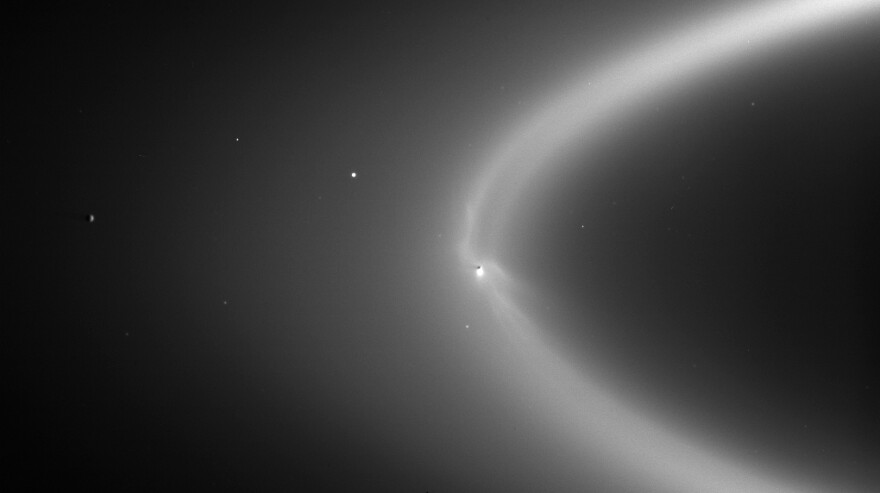What we have here is a moon — a small one (slightly wider than the state of Arizona) — circling Saturn.
If you look closely, you will see a small splay of light at its top, looking like a circular fountain.
That's because it is a fountain — of sorts. A bunch of volcano-like jets are sending fantastically high geysers of water vapor up into the sky, so high that you can see them in this remarkable print by Michael Benson, back lit by light bouncing off of Saturn.
It turns out this moon, called Enceladus, is a snowball containing what may be a sea of liquid water, warmed by the squishes and stretches of Saturn and other moons that pass nearby (plus it may have a hot, rocky core.) All that gravity pushing and pulling on this little ball squeezes the liquid inside so it shoots up through some fissures at the top.
Nobody knew these fountains were there until the Cassini spacecraft flew near enough to Enceladus to find them. But now comes the amazing part.
Water Hose In The Sky
Some of that water vapor turns into ice and the crystals fall like snow back onto the moon at a rate of 0.02 inches a year; but some ice is thrown so high, it joins a ring around Saturn, one of the outer rings, labeled "E."
Take a look at this image of the same moon, Enceladus — it's the dark spot inside the bright flare — getting real close to the E ring. According to Sascha Kempf of the Max Planck Institute for Nuclear Physics in Heidelberg, this moon is "feeding" water crystals into Saturn's ring.

Who knew that a moon could spray ice onto a planetary ring? Before these photos were taken, scientists thought teeny meteorites, called micrometeoroids, would slam into Saturn's moons kicking up dust (adding to dust from a long exploded moon) and that's how the rings were formed.
Nobody imagined that the rings would be fed by geysers. But that seems to be what's happening to the E ring. According to Kempf, the ring will carry those ice nuggets around Saturn for an orbit or two, until they meet the moon again and are recaptured. But some crystals just keep circling and circling for 50, maybe 400 years.
The E ring is astonishingly thin. Its debris is thousands of miles across, but often only 3 meters (about 9.3 feet) high. A giraffe traveling on this ring would poke out like a giant.
Seeing "True Color"
Michael Benson just published his print of water shooting off Enceladus from a digital transmission sent by the Cassini probe. It appears in his about-to-be published book Planetfall: New Solar System Visions.
What Cassini saw came back as a batch of digital information — lots of ones and zeroes — which can be turned into black and white images. Working from a series of picture fragments that Cassini transmits in small batches, Michael put them together into a single shot, then chose the hues and levels of light based on what is called "true color," what a person would see if he happened on the scene.
"I believe I was the first to see this sight the way it would appear to an actual visitor, simply by virtue of having logged the time to create the composite image, which is made of 19 raw spacecraft frames, and took several days to composite," he wrote me.
This is the way I like to tour the solar system. Find a chair. Sit. Turn some pages. Gaze. Wonder. The price isn't bad, either.
Copyright 2021 NPR. To see more, visit https://www.npr.org.



